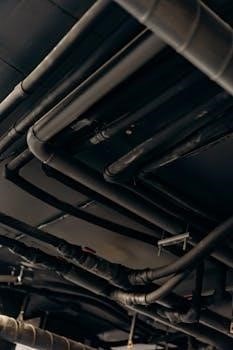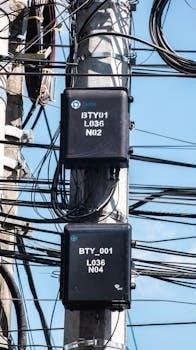Electrical conduit installation provides a protective raceway for wires, ensuring safety and reliability. This guide offers a comprehensive understanding of its purpose, types, and installation techniques, safeguarding electrical wires from damage and environmental hazards.
Purpose and Importance of Conduit
Electrical conduit serves as a crucial protective system for electrical wiring, safeguarding it from physical damage, moisture, and chemical exposure. Its primary purpose is to ensure the longevity and safety of electrical systems within residential, commercial, and industrial settings. By encasing wires, conduit minimizes the risk of electrical shock, fire hazards, and equipment malfunctions. Proper conduit installation is essential for maintaining compliance with safety regulations and providing a reliable pathway for electrical current, ultimately contributing to a secure and efficient electrical infrastructure.

Types of Conduit Materials
Various conduit materials exist, including steel (RMC, IMC, EMT) and PVC. Each type offers unique properties like durability and flexibility. Selecting the right material ensures optimal protection for electrical wiring.
Steel Conduit (RMC, IMC, EMT)
Steel conduit offers robust protection for electrical wiring in various forms⁚ Rigid Metal Conduit (RMC), Intermediate Metal Conduit (IMC), and Electrical Metallic Tubing (EMT). RMC provides heavy-duty protection, while IMC offers a lighter alternative. EMT, being the lightest, is suitable for protected locations. Steel conduit is often used with supplementary PVC coating. Adhering to installation procedures enhances electrical safety.
PVC Conduit
PVC conduit, made from polyvinyl chloride, serves as a non-metallic alternative for encasing electrical wires, offering resistance to corrosion and ease of installation. It’s crucial to adhere to installation guidelines, including proper cutting, bending, and joining techniques using solvent cement. PVC conduit expands and contracts with temperature changes, so expansion fittings may be necessary for long runs. Always consult manufacturer’s specifications and local codes for proper usage and safety.
Compliance with Electrical Codes and Standards
Compliance with electrical codes is vital when installing conduit. These codes ensure the safe and proper installation of electrical systems, providing guidelines for industry standards and safety regulations to be followed.
Importance of Following Regulations
Adhering to electrical codes and regulations is paramount for ensuring safety and preventing hazards during conduit installation. These regulations, often based on standards like those from ANSI and NECA, dictate proper installation methods, material specifications, and grounding techniques. Compliance minimizes the risk of electrical shocks, fires, and equipment damage, protecting both installers and end-users. Following regulations also ensures the long-term reliability and performance of the electrical system. Ignoring these guidelines can lead to costly repairs, legal liabilities, and potentially life-threatening situations.
Tools and Materials Required
Successful conduit installation requires specific tools and materials. This includes cutting and bending tools for preparing conduit, plus fittings and connectors for secure connections. Selecting the right tools is crucial for efficient and code-compliant work.
Cutting and Bending Tools
Accurate cutting and bending are essential for professional electrical conduit installation. Cutting tools include hacksaws, conduit cutters, and power saws, ensuring clean and precise cuts. Bending tools, such as hand benders or hydraulic benders, allow for creating necessary angles and offsets. Selecting appropriate tools depends on conduit material (steel, PVC) and size. Proper handling ensures safety and prevents damage, maintaining conduit integrity. These tools are critical for achieving neat, code-compliant installations, minimizing waste, and ensuring the long-term reliability of the electrical system. Using the correct tools is vital for safety and efficiency.
Conduit Fittings and Connectors
Conduit fittings and connectors are crucial for creating secure and continuous pathways in electrical systems. These components join conduit sections, connect conduit to boxes, and provide access for wiring. Common types include couplings, elbows, connectors, and bushings. Proper selection ensures compatibility with conduit material (steel, PVC) and size. Fittings must maintain grounding continuity and provide environmental protection. Installation involves tightening screws, using adhesives, or compression methods. Correctly installed fittings prevent moisture ingress, protect conductors, and maintain the integrity of the raceway system, ensuring a safe and reliable electrical installation that meets code requirements and industry standards.

Step-by-Step Installation Process
The installation process involves several key steps, including cutting, preparing, and potentially bending the conduit. This ensures proper fit and alignment. Securely fasten all components, paying close attention to maintaining electrical safety.
Cutting and Preparing Conduit
When cutting conduit, it’s vital to ensure clean, straight edges for secure connections. Handsaws or specialized conduit cutters offer precise cuts, minimizing mechanical damage. Remove any burrs or sharp edges from the cut ends to protect wires during pulling. Proper preparation of the conduit ends ensures a tight fit with fittings and connectors. Always use appropriate safety gear. Following these steps helps maintain the integrity of the electrical system.
Bending Conduit (if applicable)
Bending conduit, when required, demands precision to avoid kinks or flattening. Use specialized conduit benders for accurate angles and smooth curves. Heat bending is a common technique for PVC conduit, ensuring flexibility without compromising the material’s integrity. Proper bending maintains the inner diameter, facilitating easy wire pulling. Always adhere to manufacturer guidelines for bending radii and temperature settings. Ensure bends meet code requirements for a safe electrical installation.
Conduit Support and Spacing
Proper conduit support prevents sagging and damage, ensuring long-term system integrity. Spacing requirements vary based on conduit type and size. Adhering to these guidelines maintains the electrical system’s reliability and safety.
Proper Support Methods
Selecting appropriate support methods is crucial for maintaining the structural integrity of the conduit system. Various options, like straps, clamps, and hangers, cater to different conduit types and installation environments. Proper support prevents sagging and protects the conduit from physical damage. Consider environmental factors like temperature and vibration when choosing support hardware. Ensure that supports are correctly sized and installed per code requirements to guarantee long-term reliability. The chosen method should facilitate conduit expansion and contraction, preventing undue stress on connections. Following best practices guarantees a safe and durable electrical raceway.

Considerations for Thermal Expansion and Contraction
Thermal expansion and contraction are vital considerations, especially with PVC conduit. Changes in temperature cause expansion or contraction, potentially stressing connections. Calculating expansion is essential for a robust installation.
PVC Conduit Expansion Calculations
PVC conduit expands or contracts significantly with temperature changes, requiring careful calculation. The expansion rate is approximately 3 x 10-5 inches per inch per degree Fahrenheit. To determine the total length change, use the formula⁚ ΔL = L x C x ΔT, where L is the conduit length, C is the coefficient of expansion, and ΔT is the temperature change. Accurate calculations prevent stress and ensure the system’s integrity and longevity. Ignoring these calculations may lead to significant structural issues.
Grounding and Bonding
Proper grounding and bonding are crucial for safety in electrical conduit systems. These practices minimize shock hazards and ensure a safe, reliable system by providing a low-impedance path for fault currents.
Ensuring Proper Grounding Connections
Ensuring proper grounding connections within an electrical conduit installation is paramount for safety. Grounding creates a low-impedance path, allowing fault currents to safely return to the source, thus tripping circuit breakers or fuses and minimizing the risk of electrical shock. Connections must be mechanically sound and electrically conductive, using approved methods and materials. Cleanliness is vital, removing any corrosion or coatings that might impede current flow. Proper grounding ensures a safe and reliable electrical system, protecting both people and property from potential hazards.

Safety Precautions
Prioritize safety when working with electricity. Always de-energize circuits before commencing work. Employ appropriate personal protective equipment (PPE). Follow established safety procedures meticulously to mitigate risks and ensure a secure working environment.
Working with Electricity
Working with electricity requires strict adherence to safety protocols. Always assume circuits are live until verified otherwise. Utilize appropriate lock-out/tag-out procedures during conduit installation and maintenance. Never work alone; ensure a qualified colleague is present for assistance and emergency response. Inspect tools and equipment for damage before each use. Maintain a clean and dry work area to prevent slips and electrical hazards. Consider appropriate personal protective equipment such as gloves, safety glasses, and insulated tools. If unsure about any procedure, seek guidance from a qualified electrician.